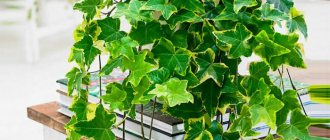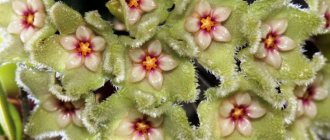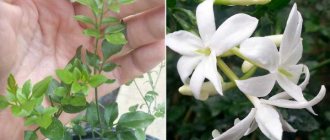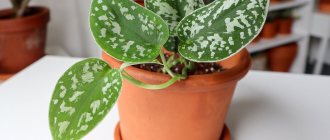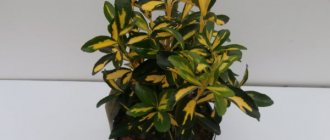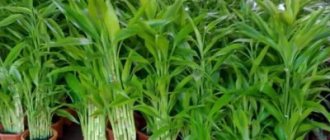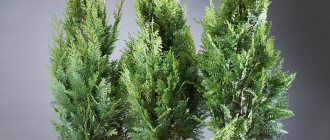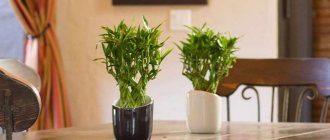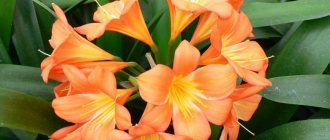Rejuvenation and propagation of indoor vines
Many indoor vines shed their lower leaves as they mature, leaving behind a bare vine with a dozen leaves at the end.
This happens especially often in herbaceous vines after winter. In this case, the plant needs rejuvenation: the apical cutting with leaves is cut off and rooted. The old plant is cut to almost half: this way it will branch more strongly. The sections must be treated with a weak solution of potassium permanganate. The apical cutting, cut from an old plant, can be placed in water so that it takes root. But many indoor vines (like Ivy) have aerial roots, and therefore the cuttings can be immediately dug into the ground.
For quick rooting, a cutting cut is treated with “Kornevin”, or folk remedies - aloe juice or Kalanchoe juice.
In addition to the vegetative method, vines are propagated by seeds. For example, I sowed Passionflower and got very good results in the form of strong shoots. But I do not recommend propagating other types of vines in this way.
In addition to seed propagation and rooting of apical cuttings, some vines can be planted using a propagation method such as dividing a bush.
Three propagation methods are used for garden ivy
- Cuttings.
- Rooting cuttings.
- Dividing old bushes.
Old, overgrown ivy that has turned into entire colonies, some of the shoots of which have taken root and sprouted, can be divided. It is not necessary to dig up the entire plant for this: it is enough to separate some of the plants around the perimeter and use them as independent seedlings.
With any reproduction method, you should adhere to the general rules:
- For rooting both cuttings and layering of ivy, annual shoots are chosen, or, in extreme cases, biennial shoots.
- When choosing branches, it is worth examining them carefully: semi-lignified, strong shoots with visible aerial roots or their rudiments give results faster than very young branches.
- It is best to propagate ivy in spring or the first half of summer.
Young ivy obtained independently can be planted in a permanent place in early autumn and spring. For the middle zone, spring planting is preferable, because in this case there is much less risk of losing plants in the event of extreme weather, and there is more time for adaptation before the first wintering.
Rooting ivy cuttings in water.
Is it worth growing it at home?
Of course, indoor ivy is worth growing at home, because it has many useful properties:
- Hedera has an anti-inflammatory effect, so it helps with various inflammatory infections.
- The fruits are used to reduce blood pressure and improve well-being.
- You can make infusions from the leaves that help treat coughs and joint pain.
- Infusions from the roots help with burns, boils and scabies.
- Hedera is one of the ingredients in the decoction for bladder stone problems.
- In addition, the loach cleanses the air of harmful chemical components (benzene, xylene).
Types of garden ivy
In nature, there are about one and a half dozen of its varieties, the most famous of which are:
- Colchis ivy (Hedera coichica). The plant has large matte dark green leaves, the width of which reaches 17 cm and the length of up to 20 cm. The leaves have different shapes and have a specific smell with a nutmeg tint, which appears when rubbed. Flowering occurs in autumn. Flowers that have no decorative value are collected in clusters on peduncles up to 3 cm long; the length of the flower petals reaches 4.5 mm and the width is 2.5 mm. The fruits ripen in the spring of next year. The most popular forms of Colchis ivy are jagged, purple and tree-like. The plant can grow up to 30 meters and is found on the Black Sea coast of the Caucasus;
Common ivy (Hedera helix). This plant reaches a height of one meter. It has leathery, shiny leaves with many decorative variations of different colors and shapes - winter form with large light ones, palmate with large five-lobed ones, Baltic frost-resistant with small ones, bordered with a yellow border and others. It blooms in the same way as Colchis ivy. It is found in the lowlands and foothills of Southern Europe, Southeast Asia and Russia. Considered one of the most frost-resistant species;
Pastukhov's ivy (Hedera pastuchowii). The plant can grow up to 10 meters long. It has thin, leathery, bright green leaves up to 10 cm long and up to 6 cm wide. Their shape is very diverse - from lanceolate to rounded-heart-shaped, with wavy-angular or entire edges. Found in Azerbaijan, Georgia, and Dagestan.
Indoor ivy is one of the most common indoor plants, often planted together with fuchsia or pelargonium. Canadian ivy is especially popular because of its variegated leaves.
As for other varieties, Thorndale and Modern Times are characterized by active growth, which allows them to be used in vertical plantings. Varieties Sally, Deltoidea and Tripod exist in both climbing form and form dense bushes. This feature allows them to be used both in vertical gardening and in pots. They grow quickly and form lush hedges up to two meters high.
Compact species like Dealbata, Henriette, Jubilee and Very Merry are excellent for covering alpine slides. A wide palette of their shapes and shades will decorate any rock garden and allow you to create your own unique style.
Hedera (Indoor ivy)
Indoor ivy (Hedera) is a plant that is especially loved by florist designers. This beautiful indoor flower has become popular due to its hanging looped stems with beautiful decorative dark green leaves. This feature allows it to be used for interior decoration. As a rule, ivy is combined with fuchsia or pelargonium, but it also looks attractive alone. Even a novice gardener can grow the plant.
Growing at home
This evergreen plant can, and to a certain extent, should be grown at home. The name of the species itself indicates the place where it was planted. But some residents of European countries prefer to plant ivy not in the house itself, but around it. Indoor ivy has a number of beneficial properties that have a beneficial effect on human health.
To care for ivy at home, you must follow certain rules. Care consists of several important stages:
- Choosing a location. The location should not be too sunny, but not too shady. A golden mean is needed. Although indoor ivy is shade-loving, it still requires sun for successful development and growth. At the same time, caring for indoor ivy should be protected from direct sunlight.
- Priming. You should also take care of the soil for the plant. In this case, it is preferable to choose light, but at the same time nutritious soil. Such soil can be purchased at a specialized store. If desired, you can make your own nutrient soil. The process of making soil includes mixing equal portions of sand, humus, peat and leaf soil. Before placing the resulting mixture into the pot, place expanded clay on its bottom.
- Air humidity. It is worth taking care of the air. Indoor ivy urgently needs moist air, so the plant should be sprayed with water as often as possible in the summer, when the weather is hot outside. In winter, spraying may be necessary if the indoor plant is in a very warm room.
Temperature and watering
Temperature. While maintaining air humidity, you should monitor the temperature. The most acceptable temperature for indoor ivy is no more than 24 degrees. It is at this temperature that the plant is able to actively grow. This temperature applies to summer time. During this period, it would be a good idea to take indoor ivy out into the fresh, street air. In winter, the temperature should not fall below 13 degrees.
Watering. Indoor ivy, like other plants, needs constant watering. The abundance and frequency of watering shrubs depends on what time of year it is outside. In the summer, when the weather is hot outside, it is recommended to water the bushes generously and as often as possible. In winter things are a little different. During cold weather, ivy enters a kind of dormant period, so at this time it is advisable to reduce the abundance and frequency of watering
It is important to maintain balance when watering the plant. The earth should not remain dry, but at the same time be damp
Feeding and pruning
Feeding and pruning. Indoor ivy needs to be fed regularly. Mineral or organic fertilizers can be used as fertilizing. It is recommended to feed ivy bushes at least once every two weeks.
In addition to feeding, it is important to prune. Both outdoor and indoor plants need timely pruning.
Trimming ivy allows you to return it to its original shape and rejuvenate it. The procedure is performed before the growing season begins. By pruning we can mean:
- pinching young stems;
- pruning old branches - in the case of indoor plants, the branch should be cut from the root no more than half a meter;
- removal of damaged or diseased shoots.
Timely pruning is vital for indoor ivy.
Features of care
It is great luck for a gardener to keep ivy in his garden plot. Just like geranium, this plant does not require any special care.
Ivy easily adapts to spring and autumn weather. Withstands temperatures from 7°C to 14°C. In summer it requires more watering than in spring or autumn. In hot weather, ivy bushes should be sprayed more often. To ensure longevity of shoots and cuttings, you should constantly pinch the ends of the stems to the ground. This will ensure the growth of new shoots.
Note! Spider mites and scale insects are direct enemies of ivy.
Ivy after transplanting into a pot
Mulching and soil care
In case of special need for growing ivy, fertilizers are used: both organic and mineral. To keep ivy healthy, as well as the ground underneath it, mulching is used. To do this, it is dug in and then covered with compost, as well as humus from leaves and sawdust.
Proper watering
Proper watering and timely irrigation of the soil are very important for any plant, including ivy. This is especially necessary in hot and dry seasons. There are several types of watering:
- rain (natural), but not regular in summer;
- superficial (regular from a hose);
- drip (spraying with a spray bottle).
Note! All types of irrigation directly depend on natural features, as well as available irrigation equipment.
Trimming
A procedure that has a positive effect on the growth and development of the plant. Ivy pruning should be done in summer and autumn. The procedure is carried out with ordinary garden shears. All dried leaves are cut off, as well as excess leaves that stick out in different directions and have a not very pleasant appearance.
Ivy pruning is done not only for the sake of appearance, but also to renew the stems. Thus, the plant is saturated with oxygen, which contributes to further successful growth. After properly trimming the ivy, the garden area will look very neat and well-groomed. Outdoor ivy is a pleasure to plant and propagate!
Proper pruning of leaves
Although ivy is common in nature, not everyone can properly care for it. The owner of this amazing plant should carefully monitor watering, excess growth and soil, and then the plants will reward you with their beautiful branching appearance.
Description
The hoya flower is an evergreen vine that can grow up to 6 meters in length. The color of the leaves ranges from brown-green to dark purple. The leaves are leathery to the touch, but a characteristic feature of Hoya is a small waxy coating on the green plates. Young shoots tend not only to grow to enormous sizes, but also to become lignified over time.
The flowers of the plant are collected in one large inflorescence, which often consists of 50 elements, the diameter of each of which is from 1 to 2 centimeters. The buds are white or brown, velvety to the touch. During flowering, hoya produces a huge amount of nectar, so the crop is classified as a honey plant. If you decide to start growing this vine, then be prepared for the fact that every year there will be a sweet aroma in the house.
Some gardeners may think that since the flower is popularly called wax ivy, it is poisonous. This is a deep misconception. In fact, hoya is absolutely harmless, and some psychics even claim that the plant can reduce the aggression of those people who live in the same room with it. Although it should be noted that some allergy sufferers may experience attacks of headaches during the flowering period of the crop - it gives off a very pungent odor.
Growing and caring for ivy at home
Caring for indoor ivy is not difficult.
Even an inexperienced gardener can grow an indoor ivy flower if he follows simple care rules that do not take much time.
Requirements for soil and pot
For an exotic flower, select a small pot with large drainage holes. The plant prefers loose and fertile soil with a neutral or slightly acidic reaction. The optimal composition of the substrate includes leaf, turf, humus soil, peat and sand in equal parts.
Microclimate, proper lighting
A climbing plant from a subtropical climate loves moderate heat and moisture.
- During the active growing season, a comfortable temperature range is considered to be 22 – 24°C. In winter, temperatures may drop, but not below the maximum permissible value of 13°C.
- To create conditions close to natural, the flower should be sprayed with settled water throughout the year and bathed in a warm shower.
- Ivy, or hedera, is a shade-tolerant plant and can grow even in the back of a room. However, the more diffused light the plant receives, the more spectacular it will look. Therefore, when choosing a place that should be decided upon even before purchasing a flower that does not like to move, preference should be given to well-lit areas.
How to properly water indoor ivy
A climbing flower with decorative foliage is an ideal plant for people who are often away from home. Ivy can withstand soil drought, but you should not use this quality of the plant too often. The optimal irrigation regime involves maintaining constantly moist soil in the summer without stagnating moisture in the root system. In winter, watering is reduced: before the next portion of water, the earthen lump should dry out slightly.
Feeding and fertilizers
In the spring-summer period, which is when the potted crop grows intensively, ivy is fed every two weeks. For fertilizing, special liquid fertilizers for decorative foliage plants are used.
Replanting ivy
You can replant the plant according to the same rule as other indoor flowers: young specimens - every spring, adults - with an interval of 2 years. But you should know that an indicator of the need for the procedure is the appearance of ivy roots in the drainage holes.
The transplant is carried out as follows:
- A new pot is selected that is 2 cm wider than the old one.
- Expanded clay or gravel is placed at the bottom of the container to create a drainage layer.
- A flower with an earthen lump is transferred to the drainage.
- A new substrate is poured into the pot so that there is a small gap between the wall and the earthen lump for irrigation water.
- The flower is watered, sprayed and returned to its permanent place.
Watch this video on YouTube
Planting garden evergreen ivy
The finished young plant can be planted in a permanent place in the spring.
| The necessary conditions | Recommendations |
| The soil | Must be moisture permeable and loose, have neutral acidity. You can prepare the soil yourself. Soil composition: turf and leaf soil, peat, river sand in the ratio: 2:1:1:1 |
| Planting hole | Optimal dimensions: 50x50x60 |
| Supports | Supports for the development of the vine must be provided in advance; these can be pergolas, arches, fences, large trees. When planting next to a tree, it is necessary to regularly trim the ivy, otherwise it will strangle “its partner” with its vines. |
| Drainage | Drainage made of broken bricks and expanded clay is poured into the bottom of the planting hole. |
| Landing | The prepared soil mixture is poured into the hole, the plant is planted and sprinkled with soil on top, the top layer is compacted. The cuttings are attached with clamps to the supports, then they will begin to cling to the roots - the suction cups themselves. |
| Watering | Water abundantly, but without stagnation of water |
| Mulching | The best mulch is rotted leaves. Ivy especially “loves” the leaves of apple, hazel and oak trees. |
| Distance | The distance between plants is maintained at 50-60 cm. |
Choosing a location and proper lighting
- Hedera requires a semi-shaded location. Sometimes a flower pot is even placed in the middle of the room, far from the window sills.
- Despite its love of shade, ivy needs sunlight to thrive in the home. Variegated species require more sun to keep the foliage attractive and vibrant in color.
- If hedera is grown as an hanging plant, then choose a wall well lit by the sun. The flower does not tolerate frequent changes of location; it is advisable to immediately select a permanent place for it.
How indoor ivy or hedera propagates
Hedera ampelous
Important! If exposed to direct sunlight, the young foliage of the plant can get burned. Hedera feels uncomfortable near heating appliances
Planting and replanting hedera
If you notice that the plant has stopped growing and developing, or roots have begun to crawl out of the drain hole in the pot, then it is time to replant. However, you don’t have to expect the indicated signs, but simply replace the top layer of soil with fresh one (in adult plants), replant young ivy every year, and older hedera once every two years. It is recommended to use the following soil composition: sand, peat, turf, leaf and humus soil in equal proportions. Plants must be replanted in the spring after the end of the dormant period (March-April). The container should be 2-3 cm larger in diameter than the previous pot. Before replanting, the heder should be watered generously and a layer of drainage should be placed at the bottom of the flowerpot. The transplanted plant needs to be watered and sprayed, and then placed in a permanent place
Description of garden ivy (Hedera)
This type is the most common due to its increased resistance to cold and unpretentiousness. Ivy can be grown as a houseplant, but it also looks great in the garden.
Decorating the inside of the house with ivy shoots
Garden ivy - evergreen and frost-resistant
Winter-hardy common ivy is popular in Russia. The first two years mark slow growth. The plant is used as a ground cover crop and for landscaping vertical structures.
For your information! Ivy prefers partial shade without wind.
Characteristics of garden evergreen ivy
The shoots of a climbing vine can reach 30 m. It is firmly attached to a vertical wall or tree due to its sucker roots.
In total there are 15 types of ivy and over 1000 varieties. The leaves may vary in color, size and shape depending on the variety.
Variegated species are given a certain decorativeness by the white border of the leaves, dark or light inclusions in comparison with the main background. The leaves are dense to the touch with a smooth surface. October and September are considered the flowering period of the plant. Light green inflorescences in the shape of umbrellas.
Important! The fruits of the flower are poisonous, they look like black peas with a blue tint
Types of ivy for the garden
Is it possible to keep ivy at home?
Ivy is one of the ten easiest plants to grow at home. However, keeping a hederah in the home is not suitable for everyone.
Dust on ivy leaves and flowers can cause allergies in sensitive people. Hedera may cause symptoms such as sneezing, eye irritation, watery eyes, or shortness of breath.
For this reason, many people believe that hedera should not be grown indoors.
Types of indoor ivy, photos and names
The main type of ivy is Hedera helix, or common ivy. Many varieties grown in gardens and at home are descended from this species. Those that are suitable for indoor growing usually have small leaves.
Popular varieties of potted ivy include:
- “Chicago” – with small light green leaves, very hardy.
- “Glacier” – This type of Hedera Helix is distinguished by small, dark green leaves with a thin white border along the outer edge.
- “Vander” is an ampelous species with white-green leaves.
hedera helix wonder Hedera Helix Chicago hedera helix Glacier
Other types of ivy are also grown in pots. Among them it is worth paying attention to:
- Persian ivy, or Hedera colchica, native to Iran, is extremely resilient. It grows very quickly and has the largest leaves, 15-20 cm in diameter.
- Canary ivy (Hedera canariensis) is a type of ivy that is easy to grow and looks very good as a houseplant.
- Gloire de Marengo (Algerian ivy) is one of the most popular varieties, characterized by dark spotted leaves with a white curly border.
Hedera colchica Gloire de Marengo Hedera canariensis
How to propagate ivy
Propagation of ivy plants is a simple process. It does not require special skills, large material and time costs. Those who are interested in the question of how to propagate indoor ivy should know that there are two main methods - cuttings and rooting layering.
Ivy in the interior
How to grow ivy from cuttings
The most popular and frequently used method is propagation of ivy, or hedera, by cuttings. It is very easy to obtain high-quality planting material for this. Ivy-shaped plants grow quite quickly and cutting shoots for cuttings does not cause any particular inconvenience to the flower.
Harvesting cuttings can begin in the spring and continue throughout the summer season. During this period, young cuttings have time to gain strength, because it is recommended to use only new annual shoots for cutting. Lignified branches are not suitable for this method of propagation.
Important! If you take cuttings in the fall, the plant most likely will not be able to survive the winter. During this period, ivy prepares for dormancy, stores up nutrients, and stops forming new stems.
Propagation by cuttings
The length of the cuttings should be approximately 15 cm. On each of them you need to make an oblique cut and leave at least 3 leaves on the top. In addition to the leaf blades, the cuttings should contain at least one fully formed node.
Before planting cut shoots in the ground, you need to keep them in a special solution that stimulates their growth and rapid rooting.
Landing rules
How to grow ivy from a cutting? First of all, you need to select a suitable container for planting a flower and create the necessary conditions in the room where it will subsequently be kept. Another important point to consider before planting is the preparation of the substrate. You can purchase a ready-made product in stores or make a soil mixture yourself by mixing humus, loose turf soil and river sand.
How to plant ivy in a pot:
- Pour in the substrate: a little more than half the pot.
- Deepen the cuttings into the soil by a third.
- Moisten the soil.
- Place the container in a lighted and comfortable place to keep it.
Important! Do not use acidic soil for planting. To reduce acidity, you need to add a little ash or lime to the substrate
The plant is not propagated by layering as often as by cuttings.
How to propagate ivy by layering
This method is not as popular as the previous one, but it is also quite simple. The procedure is carried out in spring or early summer. Ivy propagation using layering occurs according to the following algorithm:
- Choose a healthy but young shoot from indoor ivy.
- If the shoot is not very long, it can be fixed in the ground in the same pot where the mother bush itself grows. Otherwise, you should prepare a separate container with the substrate.
- Place the containers nearby and dig the shoot into the ground, leaving the top of the stem 10-15 centimeters above the ground. The layering can be secured with a staple or wire.
- Regularly water and loosen the soil in the container.
- After rooting, the cuttings are cut off from the mother bush.
- If necessary, transplant into another pot.
Note! This method is not suitable for propagating wax ivy. Ivy seeds are difficult to purchase in stores and even on the Internet, since propagating the plant in this way is a very labor-intensive and wasteful process
Seedlings practically do not sprout and have difficulty taking root after transplantation.
Ivy seeds are difficult to purchase in stores and even on the Internet, since propagating the plant in this way is a very labor-intensive and wasteful process. Seedlings practically do not sprout and have difficulty taking root after transplantation.
Garden ivy: evergreen common ivy and its ornamental varieties
Claiming to be a garden classic, ivy rightfully occupies a leading position in the list of unpretentious garden vines. Versatile and hardy, fast-growing and low-maintenance, garden ivy is suitable for a wide range of applications. With the help of ivy they camouflage and decorate, create green walls, plant greenery on facades, and play with small architecture objects. And not the last factor in the prevalence and unfading popularity of ivy is the ease of its propagation. Easy to cut and root, ivy allows you to obtain seedlings without much expense or effort.
Common ivy (Hedera helix).
Ivy is one of the garden plants that practically needs no introduction. The hallmark of the genus Ivy (Hedera), the most common plant was and remains common ivy (Hedera helix) and its numerous decorative varieties, differing in shape, size and color of leaf blades. A creeping evergreen vine with flexible, long, branching shoots that take root at nodes and have aerial roots is a plant whose size is limited only by its use. If ivy is given free rein, it can grow to more than ten meters. But with proper shaping and limitation, they will surprise you with their compactness and modest size. Three- or five-lobed leaves, located alternately on the shoots on long petioles, captivate with their leathery-glossy texture, dark colors, light veins and heart-shaped base. Flowering, which starts in ivy only at an advanced age, is inconspicuous, with small yellowish flowers in umbrellas, the fruits are round black peas.
Ivy in landscape design.
In landscape design, ivies are used to create screens and screens, green carpets, façade landscaping, decorating small architectural objects, creating figured accents, masking, filling, emphasizing... Natural talents that allow ivy to conquer new heights lie in the structural features of the plant. Ivy easily climbs up, clings to supports or spreads along the soil. It is equal parts ground cover and vine, open soil plant and potted plant, main or complementary. The amazing “docility” of ivy and its versatility are the result of endurance and vitality. Not only does it adapt well to any conditions and any base that it must wrap around, but it also takes root and “fixes” easily. This ability is used in propagation: flexible shoots that easily take root in the nodes take root just as easily during propagation.
Self-propagation of ivy is a very simple task. When landscaping large areas or objects, it is enough to purchase one or two bushes of mature plants, choosing varieties based on hardiness, color, and decorative characteristics for a specific design task. From basic bushes you can quickly grow a large number of ivy seedlings. Of course, you will have to wait several years until they reach a sufficient size, but the costs of landscaping will be minimal.
For ivy, vegetative methods are preferred. Mostly in landscape design today, varietal plants are used that do not retain their characteristics when grown from seeds. It is not possible to propagate fashionable variegated or original ivy by seeds. In addition, unlike growing from seeds, any method of vegetative propagation allows you to significantly reduce the process of achieving the desired goal, maximum decorativeness. The advantages of speed and simplicity are the main arguments in favor of cuttings and related propagation methods.
Ivy cuttings.
Such similar and different vines
Almost all vines are inhabitants of the humid, warm tropics. They grow very quickly (most of them, anyway), are easily propagated by cuttings and take root quickly. Perhaps that is why gardeners love them so much. For example, a climbing cypress vine, or Quamoclitus pinnate, can grow 2.5 m during the growing season.
Despite the similarity in general characteristics, the vines are still very different. They may be flexible or have a herbaceous stem, or they may become woody as they mature. In addition, they differ in the possibilities of vegetation growth: they can be annual and perennial, evergreen and, conversely, deciduous.
Indoor vines are mostly evergreen and perennial. And this is understandable: who wants to look at a long bare stem all winter. It is herbaceous vines that are grown at home, but flexible or woody ones can be planted in the garden.
Lianas are also divided into classes depending on the method that the plant uses to attach to the surface during growth. If the vine is attached to the support by roots, then it is a root-climbing vine, if by lateral branches or shoots-tendrils, then it is climbing or tendril-bearing. And the supported vines cling to the support with suction cups.
Most often, amateur gardeners grow climbing vines. Their shoots can be twisted around a support, forming a plant with a beautiful spiral shape.
Among indoor vines there are many favorite flowering plants: Clerodendron, Ivy, Bougainvillea, Passionflower, Monstera, Philodendron, Hoya and many others. For example, I was very surprised when I learned that even among the cacti there are vines.
Botanical description
The houseplant ivy is most often represented by the species common ivy (Hedera helix) with a climbing stem and dense brushes of aerial roots on the underside of the stem, with the help of which the hedera ivy is attached to its support. The leaves of this species are alternate, simple, shiny, leathery, lobed, dark green with lighter veins, but there are also variegated forms.
The indoor ivy flower has more than a hundred forms, which differ in size, leaf shape and color.
Like many other plants of the Aral family, ivy flowers are not particularly elegant or beautiful. They are an umbrella-shaped inflorescence of green color. At the end of flowering, green berries appear, which then turn black when ripe. Flowers appear only on perennial plants. Apartment ivy usually does not bloom at home, despite careful care.
Typical representatives of the genus are woody evergreen vines. They are fixed on the supports using special aerial roots that work like suction cups. As they grow, the stems thicken, become covered with bark, and turn into massive, uneven trunks.
The leaves are entire or three-five-lobed, depending on the variety. They are arranged alternately on the stem. The most popular in demand are plants with yellowish, cream and white spots on the leaves. These forms of plants require special care, they are more capricious, they need more light and warmth in winter in indoor conditions. Typically, hedera is used in a composition for some bouquet or simply for landscaping houses and offices.
Growing ivy from cuttings
Cuttings are a fairly simple way to obtain planting material. Many types of ivy grow so quickly that the plant will not even notice the loss of several shoots.
Video: propagation of ivy by cuttings
Procurement time
Harvesting should be done in late spring or throughout the summer. It is worth remembering that only lignified shoots are used as cuttings. It is better not to touch young watery green shoots, as they take root very slowly, and under unfavorable conditions (sharp cold or high humidity) they begin to rot.
Indoor ivy is one of the most common indoor plants, and Canary and garden ivy are also especially popular.
In the fall, it is better not to carry out cuttings, since the plant is preparing for wintering; accordingly, it does not grow additional shoots, but stores nutrients in the above-ground and underground parts. If you cut off a few branches, the small bush may develop problems and not survive the winter.
How to prepare and root cuttings
For propagation, annual shoots are used, on which there are small adventitious roots or rudiments are visible. Next, you should measure 10-14 cm, and then make an oblique cut. The cuttings must have healthy leaves, as well as at least one formed node.
Video: rooting ivy cuttings using perlite
Next, all lower leaves (near the cut) are removed, after which the lower part of the shoot is dipped in a root system growth stimulator. After this, the cuttings are planted in a mixture of sand and soil in a 1:1 ratio.
Important! We deepen the planting material only by a third. Leaves should not be in the soil, otherwise they will rot.
If the weather is good outside, then the ivy pots/boxes can be taken outside. Otherwise, it is better to leave containers with cuttings in a greenhouse or well-lit room.
After 1.5 months, you can safely plant the plant in a permanent place.
Landing rules
When choosing a permanent place for a young plant, you should take into account the fact that ivy loves shade or partial shade, as well as fairly nutritious soil.
Video: how to plant ivy
If good soils are already occupied, then add a small amount of humus or compost when planting. After this, it will be enough to maintain the humidity.
Be sure to pay attention to the acidity of the substrate. Ivy will die if planted in acidic soils.
The reaction must be neutral or alkaline.
Find out why soil acidity is important for plants, how to determine the acidity of the soil on a site, how to deoxidize the soil, and how to increase soil fertility.
The best place for ivy is a damp area under the canopy of a large tree that is adjacent to the fence. In such a place, ivy will not only grow well, but will also decorate the hedge.
In large open areas, the plant will be useless, and it will have to be cared for as a demanding crop, since in the absence of shade, moisture will evaporate from the substrate much faster.
How to grow ivy from seeds?
Let's consider whether it is possible to grow ivy at home.
After flowering, the plant retains small berries. The color of the berries depends on the subspecies of the plant. There are seeds inside them. They are taken out and dried for 1-2 days . The seeds can also be placed in a growth stimulator. This procedure will increase shelf life and germination.
Bowls must be used as containers. The prepared substrate is poured into them. Place the seeds one at a time at a distance of 5-10 cm from each other . The planting is watered with water from a sprayer. It is necessary to build a mini-greenhouse on top.
Use glass jars, cut plastic bottles or transparent cellophane. Also, if the container is too wide, the bowl can be covered with plain glass.
This design maintains the greenhouse effect and stable temperature. Without a greenhouse, the seeds will not sprout . In the evening hours, future seedlings are artificially illuminated.
Since the glass cannot be opened, the seeds are watered from a tray. Water is poured onto it until it evaporates completely. It is important that drainage holes are made in the bowl. Otherwise, moisture will not enter the container.
The soil must be kept moist at all times. After 14-30 days, the first shoots should appear . After 2-3 leaves appear on the sprouts, they are transplanted into separate pots for permanent growth.
NOTE! Find out all the secrets of caring for ivy, as well as possible diseases and pests of ivy and how to deal with them.
Reproduction
Indoor ivy can be propagated by several methods. Any of them gives a good result, since this vine is quite tenacious and takes root at any opportunity.
- Cuttings. The most effective and simplest way. When pruning, a lot of planting material is formed; any branch more than 10 cm long will do. For planned planting, it is better to take shoots 10-20 cm long. They need to be placed in water at room temperature (+20…+22 ⁰С) and wait until they take root. To speed things up, you can add a growth stimulator to the water. When the first roots appear on the branches, they can be moved to a pot.
- By layering. A good method for all creeping plants. It is necessary to select a long shoot, slightly cut it in the middle, and cover the cut site with earth. It is advisable to secure the shoot itself with a staple at the incision site, otherwise it will constantly shift. After the branch takes root, it can be separated from the mother plant.
- Indoor ivy is also propagated by dripping. To do this, you need to select a long and young shoot with at least 7-8 leaves, and press it down so that it goes deeper into the substrate. The leaves should remain outside. After 2-3 weeks, roots will appear at the junction of each leaf with the vine. The shoot can be divided into parts and each specimen transplanted into a separate container.
- Propagation by seeds. The method is practically not used for two reasons: firstly, ivy is easy to propagate by other methods, and secondly, it blooms extremely rarely, so the seeds need to be specially purchased. But if you want to gain experience in germinating hedera from seeds, then this is easy to do: you need to wrap the seeds in a damp cloth for two days, and then bury them in the ground. To be on the safe side, you can add a couple of drops of growth stimulator.
Cuttings are the main method of ivy propagation
Ivy branches take root so easily that when grown indoors, cuttings are often rooted simply in water. For garden ivy, in most cases, more traditional methods are used, but it is precisely because of the ease of rooting that cuttings are the main method. The vines take root within a few weeks, and the plants develop quickly.
For cuttings from ivy, it is best to use one-year-old young shoots. Both apical and stem cuttings are suitable. The apical cuttings should not be too small: the tops of branches 10 to 20 cm long are cut at an angle (between leaf nodes). The lower two pairs of leaves are removed from the cuttings. When using stem petioles, the entire shoot is separated. For this cutting method, young branches with 8-10 leaves are used.
You can root ivy cuttings:
- in water or solution of rooting stimulants;
- in a mixture of peat and sand;
- in a light substrate with a high sand content.
However, rooting in containers or containers is not the only option. Ivy can also be propagated in a greenhouse or mini-greenhouse in open soil.
Covering with a cap and greenhouse conditions for ivy are not at all necessary. As long as stable soil moisture is maintained, cuttings of this plant can be rooted without additional difficulties. Covering the container with a glass or film cap speeds up rooting, but nothing more. Any temperature is suitable for rooting cuttings: cuttings root in both warmth and heat, when the temperature exceeds 15-16 degrees. Treatment with growth stimulants can speed up the rooting process. But it is not considered a mandatory procedure.
The apical cuttings are planted in the soil, buried 1/3 of the height to the first node with leaves. On average, rooting in the substrate takes from 2 weeks to 1.5 months; after rooting, plants can be planted in a permanent place without growing in containers or seedling beds.
Stem cuttings are laid horizontally on the surface of the substrate, pressing the shoots to a depth of about 1.5 - 2 cm (or placing them in a groove) and leaving the leaves on the surface. You can immediately cut the stem into cuttings with one leaf node (about 10 cm long), but usually the shoot is left intact. Rooting occurs within 1 - 2 weeks, after which the tip of the shoot begins to grow. After signs of resumption of growth appear, there is no need to rush to cut the stem: the plants are separated only after 2 weeks. The stem is carefully removed from the substrate and cut into separate cuttings or independent plants, separating the rooted leaf nodes.
Rooted cuttings, especially stem ones, are rarely transferred immediately to a permanent place: they can be planted either in a container or in a separate bed for growing, simplifying the process of maintaining stable soil moisture. They are planted in a permanent location at the end of summer or early autumn, giving enough time for rooting before the arrival of winter and protecting them with mulching from severe frosts. But it’s better to wait until spring and grow ivy as a container crop or cover it in a garden bed, giving the plants more time to grow roots before the first wintering.
Reproduction of ivy by layering.
Possible problems and their solutions
When growing crops, many gardeners face various problems. In such a situation, you should take action immediately.
Leaves fall
Moisture deficiency and increased dryness of indoor air lead to dryness and falling leaves. Also, the cause of problems is the active reproduction of spider mites.
Leaves turn yellow
Yellowing of foliage is caused by excess moisture. Excessive amounts of fertilizer also cause problems.
Few leaves
The cause of this problem is lack of lighting. Also, a decrease in the number and size of leaves is considered a consequence of increased air temperature.
Pale foliage
Changes in leaf color are due to lack of light. In this case, it is enough to move the culture to another place.
The tips of the leaves dry out
Dry leaves are caused by violation of the rules of care and incorrect temperature conditions. To do this, the culture is moved to a cool place.
Possible difficulties when growing ivy
Brown and dry edges of the leaves, the stem is poorly leafy . The reason is too high a temperature. Pay attention to whether there are spider mites. Trim bare stems and move the plant to a cooler location.
Small leaves. Bare twisted stems . The reason is a lack of light, although adult leaves at the base of the stem tend to fall off with age. Trim bare stems.
The leaves lose their variegated color . The reason is lack of light. Variegated varieties with a lack of light acquire an even green color. Another reason could be that the pot is cramped.
The tips of the leaves are brown and dry . Slow growth . The reason is too dry air. Look for red spider mites. Remove dead leaves. Spray the plant regularly.
Myths and reality about ivy
People believe that all living things, including plants, can give or take away energy. It is believed that ivy is an energy vampire. Some are convinced that it takes away energy, others that it gives vitality. You can use the point of view of psychoanalysts. They suggest that the plant, along with toxic emissions from furniture and tobacco smoke, absorb aggressive bursts of energy. That is why it is advised to grow ivy in a room where hyperactive children live. The plant will also cleanse the apartment of the unkind energy of the uninvited guest.
Ignoring signs, is it possible to keep indoor ivy at home? They say that the plant “muzhegon” squeezes men out of the apartment. How many families break up without ivy? The ancient Romans believed that ivy would help a girl in a successful marriage.
The reality is that the indoor ivy flower is unpretentious, purifies the air, and is not afraid of even drafts. In addition, ivy is a good natural healer and a poisonous plant.
Ivy (willow)
Ivy is a genus of plants that belongs to the Araliaceae family. The genus has 16 species, which are divided into many varieties.
Ivy plants, regardless of species or cultivar, have a creeping stem and are all subshrubs. Their shoots are divided into two types: flowering and non-flowering. On flowering shoots, the leaf blades are light green or light green and have an ovoid or oblong shape. On non-flowering leaves, the leaves are dark and angular-lobed.
The fruit is a small berry that is black or yellowish in color.
The plant is found in regions with a humid climate.
Did you know? Ivy absorbs compounds from the air that are dangerous to humans, such as formaldehyde and benzene. Thanks to this, the plant can be planted not only for decoration, but also to improve the composition of the air.
The plant can reproduce by seeds, but this method is not used in gardening, and the seeds are used exclusively for animal feed. This is because the seeds, as is the case with many other crops, do not retain the qualities of the mother plant. For decorative purposes, the plant is propagated in only two ways: layering and cuttings.
Rooting cuttings of ivy
Like other vines, ivy can be easily propagated by layering. Scourges lying on the soil are capable of taking root themselves. But you can stimulate this process and get strong independent plants. The method of rooting cuttings is most popular when using ivy as a ground cover. But it is also suitable for those who need to get a not too large number of new plants.
There is nothing complicated in the process of rooting shoots:
- Strong, flexible ivy shoots from below (for those growing vertically) and along the perimeter (for ivy growing horizontally) are placed in a small trench. Usually, long, powerful shoots are chosen for rooting cuttings. Small cuts on the underside of the branches speed up rooting.
- The branches are secured in the soil with a staple and sprinkled with a nutrient substrate on top.
- Water thoroughly and then regularly water the soil to maintain stable moisture.
After the shoots have rooted, there is no need to rush to plant cuttings. In early autumn or next spring, young ivy is separated as independent bushes and planted in a permanent place.
If the ivy has long enough branches, then they can be fixed in the soil in waves, rooting several layers from one lash at a time.
Planting ivy in a permanent place.
Rules of care
In order for ivy to develop normally, it is recommended to provide it with complete and high-quality care.
Temperature and light
This is a shade-tolerant crop that can be placed in partial shade. However, in too dark a place, ivy will not develop well. It is best to place the plant pot in a well-lit place.
Ivy is able to adapt to any temperature regime. However, the plant has difficulty accepting dry and hot air. In the warm season, it is worth providing the plant with a temperature of +22-25 degrees. In summer, the culture is transferred outside. In winter, the temperature should be +12-14 degrees. It is difficult to provide such conditions at home. Therefore, the plant should be sprayed systematically. If the culture is in a warm room, the pot should be placed in a tray with wet expanded clay.
Ambient humidity
Ivy is considered a moisture-loving plant. Therefore, in conditions of increased dry air, it is recommended to constantly spray it. It is recommended to periodically organize showers for culture.
Watering mode
The plant needs sufficient moisture. In summer, the soil is constantly moistened; in winter, the amount of watering is reduced. To do this, use soft water at room temperature.
Trimming
If there are bare shoots on the plant, they are completely cut off. It is recommended to leave 2 buds. After pruning, new shoots are formed in this area - several in one cut area.
Top dressing
It is recommended to systematically feed ivy with complex fertilizers. To do this, it is worth purchasing a mineral composition for decorative deciduous crops. Fertilizers should be applied twice a week. This is done from spring to autumn. At the same time, it is worth observing a sense of proportion. Excess fertilizer will lead to the loss of the decorative properties of the flower.
Bloom
The crop blooms in autumn. It is characterized by small yellow flowers. However, when growing crops at home, they do not appear.
Care
At first glance, caring for hedera is not difficult, but failure to comply with the maintenance conditions leads to the death of the plant, especially for novice gardeners.
Watering
The liana loves moisture, since the usual growing conditions for hedera are tropics and subtropics. The soil in the pot should always be moist, but the soil should not become acidic due to stagnant water.
When it gets colder, watering is reduced, and in winter it is reduced to a minimum. The soil should also not be allowed to dry out.
If the hedera overwinters at normal room temperature, water it as before.
Ivy loves moisture; when it gets cold, watering is reduced, and in winter it is reduced to a minimum.
Lighting and temperature
Ivy plants are considered shade-tolerant plants, but they feel more comfortable in good light. Pinnately-leaved varieties especially need it.
Direct sunlight should be avoided as it causes burns on the leaves.
Lianas are more comfortable in cool rooms: in the summer at +18°C, in the winter months - +12°C. In the summer season, vines are taken out onto loggias, balconies and terraces.
They are not afraid of sudden temperature changes and drafts. Dry air and high temperatures lead to scale insects.
Ivy loves good lighting, direct sunlight should be avoided
Humidity level
Liana is demanding on the level of air humidity. In hot weather, it must be regularly sprayed or the foliage wiped with a damp cloth.
It is not recommended to use special products to make leaves glossy.
Transfer
When the pot becomes too small, the plant is replanted. Signs that it’s time to replant ivy:
- no growth;
- wilting of leaves;
- roots peeking out of the pot's drainage hole.
Young plants are replanted annually, adult ivy - once every 2 or 3 years. It is preferable to replant in March-April.
The new container is taken 3 cm larger than the previous one. Drainage must be placed at the bottom of the pot.
Ivy transplantation:
Soil and fertilizing
The composition of the soil for ivy is not particularly important. A soil mixture for decorative deciduous indoor plants or one made independently from turf, humus, leaf soil, peat and sand is suitable.
The plant is responsive to root and foliar feeding. You can use fertilizers for decorative foliage plants.
In the warm season, fertilize every two weeks, in winter - no more than once a month. Excess fertilizer leads to yellowing of leaves.
Caring for young ivy
To achieve maximum decorativeness with ivy, you will have to be patient. This plant does not begin to grow vigorously right away, and will have to wait several years before the decorative task assigned to the vine is completed. But with proper care and optimal conditions, the waiting period can be shortened.
Conditions for ivy need to be selected carefully. They are hardy and adapt well. But if the task is to quickly garden, then you should choose places protected from drafts and wind. Air-permeable, fertile, deeply worked soil containing organic matter and moisture-absorbing soil is one of the conditions for the rapid growth of ivy.
Evergreen garden ivy.
In order for ivy to quickly reach the desired size, you first need to take care of stable soil moisture. Regular watering during drought and spraying leaves during particularly hot periods will help young plants not to suffer from extreme summer conditions and quickly grow both roots and vegetative mass. During the season, the soil is carefully loosened, preventing it from crusting, but without touching the roots and shoots of ivy. Protective cover in the first winter in the form of a simple layer of mulch will reduce problems during thaws and temperature changes. Ivy plants will not refuse a permanent mulch layer, which will protect the root system from overheating and stabilize the conditions for their development.
Did you like the article? Share with your friends and like!
Facebook Twitter VKontakte
NEWS DELIVERY BY MAIL IS CONVENIENT
When you subscribe, you will receive an email about new articles posted on the site over the past two weeks.
